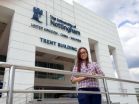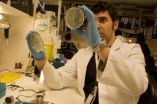(Press-News.org) Deadly skin cancers in mice shrank in response to a new treatment that may complement other "immunotherapies" developed recently to boost the body's own defenses against disease threats, according to a new study published by UC San Francisco researchers in the May 2014 edition of the Journal of Experimental Medicine.
Using a mouse version of a human drug that is popular for treating osteoporosis, the UCSF researchers discovered a way to manipulate the thymus, a gland situated at the base of the neck above the heart, to alter its activity so that some of the specialized immune cells that pass through it will go on to battle cancer cells.
"After treatment, mice that normally would be dead in a week or two rejected tumors and survived," said Mark Anderson, MD, PhD, an immunologist with the UCSF Diabetes Center and the leader of the study.
The thymus plays a key role in educating T cells of the immune system about which molecules encountered within the body belong to microbes and ought to be attacked, and which are a normal part of the body and ought to be tolerated.
Anderson and colleagues have changed this education curriculum to better fight cancer. Normally, the immune system regards tumor tissue as a part of the body, and therefore does not target the molecules found on tumor cells.
As blood courses through the inner part of the thymus, specialized thymus cells cull the subset of T cells that targets the body's own tissues, so that these tissues are not attacked by the immune system, a phenomenon called central tolerance. Anderson turned the tables, removing the thymus cells that cull the T cells.
The researchers marked these thymus cells for destruction by targeting a protein molecule they need to develop normally, called RANK-L. Treatment that inhibited RANK-L reduced their numbers by more than 90 percent. As a result of the elimination of the thymus cells, T cells that target tumors survived and escaped central tolerance. Just two weeks of treatment was sufficient to generate enough tumor-specific T cells to destroy deadly melanoma skin cancers in the mice.
One theoretical concern with the anti RANK-L strategy, Anderson said, is autoimmunity, in which the immune system destroys normal tissue, because the process of learning to tolerate "self" molecules is disrupted by treatment.
Although the researchers detected T cells that target molecules found on normal tissue, they did not observe significant autoimmune reactions in treated mice. In addition, within ten weeks of stopping treatment, immune responses were back to normal.
RANK-L plays a role not only in the development of specialized thymus cells, but also in the development of other types of cells in the body, including the osteoclasts that break down bone. The UCSF researchers used a mouse antibody targeted against RANK-L, but a human antibody directed against RANK-L forms the basis of the long-term osteoporosis treatment denosumab, which preserves bone mass by targeting osteoclasts.
Anderson suggested that patients treated with denosumab should be periodically evaluated for signs of autoimmunity or other defects in central tolerance.
Arousing the body's own immune defenses to fight cancer using immunotherapy drugs is a recent success story, with ipilimumab, a drug first developed and tested by UCSF and UC Berkeley researchers, now FDA-approved for the treatment of melanoma.
Ipilimumab turns off the brakes that restrain the immune system, acting on immune cells throughout the body. The new strategy developed by Anderson's lab team also releases the brakes on immune cells itching for a fight. But it is a distinctly different and complementary approach.
"This is another strategy for getting the immune system to no longer tolerate tumors, one that relies on different molecular components of the immune system," Anderson said.
The T cells unleashed by temporarily blocking central tolerance might clamp down on their cancer-cell targets more doggedly than weaker antibodies unleashed by other immunotherapies after central tolerance already has culled T cells, Anderson said.
INFORMATION:
Among the additional UCSF authors are postdoctoral fellows Maria Mouchess, PhD, and Yafei Hou, PhD; Lawrence Fong, MD, a UCSF oncologist and professor of medicine; and Imran Khan, an MD/PhD graduate student. Maureen Su, MD, assistant professor of pediatrics at the University of North Carolina, also is a study co-author.
The research was funded by the National Institutes of Health, by the UCSF ISIS Postdoctoral Scholars Program, and by the UCSF Medical Scientists Training Program.
UCSF is the nation's leading university exclusively focused on health. Now celebrating the 150th anniversary of its founding as a medical college, UCSF is dedicated to transforming health worldwide through advanced biomedical research, graduate-level education in the life sciences and health professions, and excellence in patient care. It includes top-ranked graduate schools of dentistry, medicine, nursing and pharmacy; a graduate division with world-renowned programs in the biological sciences, a preeminent biomedical research enterprise and two top-tier hospitals, UCSF Medical Center and UCSF Benioff Children's Hospital San Francisco. Please visit http://www.ucsf.edu.
New cancer immunotherapy aims powerful T cells against tumors
2014-05-13
ELSE PRESS RELEASES FROM THIS DATE:
First year student publishes monsoon study
2014-05-13
A first year Environmental Science student at The University of Nottingham Malaysia Campus (UNMC) has had a literature review of the Southeast Asian monsoon published in the academic journal Geoscience Frontiers. Her research concluded that future climate warming could lead to a 15 day delay in the monsoon onset in Southeast Asia by the start of the next century.
Yen Yi Loo investigated how global and regional temperature and rainfall anomalies affect rainfall patterns and the South East Asian Monsoon. She also highlighted how increased rainfall intensity in the last ...
New agent may enhance effectiveness of radiotherapy
2014-05-13
Scientists from The University of Manchester – part of the Manchester Cancer Research Centre - have demonstrated the potential of a drug to improve the effectiveness of radiotherapy in stopping tumour growth.
There is increasing interest in using the body's own immune system to attack tumour cells – a strategy that can be very effective without the side effects associated with conventional chemotherapy.
Skin cancers have been successfully treated using a topical cream, imiquimod, which recruits immune cells through a molecule known as toll-like receptor 7 (TLR7), a ...
Arthroscopy of the knee joint for arthrosis: No benefit detectable
2014-05-13
The benefit of therapeutic arthroscopy with lavage and possible debridement for the treatment of arthrosis of the knee joint (gonarthrosis) is not proven. There was no hint, indication or proof of benefit of therapeutic arthroscopy in comparison with non-active comparator interventions, e.g. sham surgery, for any patient-relevant outcome. From the active comparator therapies, only the injection of glucocorticoids into the knee joint produced worse results than arthroscopy for the outcome "global assessment of the symptoms of gonarthrosis".
This was the result of the ...
Identified 2 new genes involved in the more aggressive prostate cancer
2014-05-13
A study by the Columbia University Nova York, in collaboration with the Catalan Institute of Oncology , Belvitge Biomedical Research Institute (ICO-IDIBELL) has identified two new genes that lead to more aggressive forms of prostate cancer. The work done by Alvaro Aytes under the direction of Cory Abate-Shen , director of the Herbert Irving Comprehensive Cancer Center of the Columbia University, has been published in the latest issue of Cancer Cell.
Prostate cancer
Prostate cancer is the most common in men in Europe( accounts for 20% of all male tumors). The incidence ...
A tale of survival
2014-05-13
Frankfurt am Main, Germany, May 12, 2014. Hydrogen sulphide (H2S) is a potent inhibitor of aerobic respiration. However populations of shortfin molly fish managed to colonise springs with high concentrations of dissolved hydrogen sulphide. In a new study researchers from LOEWE Biodiversity and Climate Research Centre (BiK-F) and the Goethe University Frankfurt present evidence of genetic changes minimizing the harmful effects of H2S which enable the fish to survive in this deleterious environment. The study provides insight into the molecular mechanisms of this key adaptation ...
Bird invaders 'moving in' to UK's nature reserves
2014-05-13
A new study by scientists at the University of York and the RSPB Centre for Conservation Science has demonstrated that nature reserves and other areas specially protected for wildlife, as well as being vital for native species, are very important for helping European birds to expand their ranges into Britain naturally. The catch is that protected areas are also at increasing risk of invasion by species that have been introduced from further afield.
The research, published in the journal Diversity and Distributions, explores how the UK's special places for nature have ...
Comet theory false; doesn't explain Ice Age cold snap, Clovis changes, animal extinction
2014-05-13
Controversy over what sparked the Younger Dryas, a brief return to near glacial conditions at the end of the Ice Age, includes a theory that it was caused by a comet hitting the Earth.
As proof, proponents point to sediments containing deposits they believe could result only from a cosmic impact.
Now a new study disproves that theory, said archaeologist David Meltzer, Southern Methodist University, Dallas. Meltzer is lead author on the study and an expert in the Clovis culture, the peoples who lived in North America at the end of the Ice Age.
Meltzer's research team ...
Chemists design molecules for controlling bacterial behavior
2014-05-13
Chemists in the College of Arts and Sciences have figured out how to control multiple bacterial behaviors—potentially good news for the treatment of infectious diseases and other bacteria-associated issues, without causing drug resistance.
Yan-Yeung Luk, associate professor of chemistry, has spearheaded the discovery, in conjunction with his research lab at Syracuse University and the Wang Lab at SUNY Upstate Medical University. Their findings are the subject of a forthcoming article in the journal ChemBioChem (John Wiley & Sons Inc.).
"Since the discovery of the first ...
UCSF: E-cigarettes expose people to more than harmless vapor, should be regulated
2014-05-13
In a major scientific review of research on e-cigarettes, UC San Francisco scientists found that industry claims about the devices are unsupported by the evidence to date, including claims that e-cigarettes help smokers quit.
The review marks the first comprehensive assessment of peer-reviewed published research into the relatively new phenomenon of electronic cigarettes.
The devices, which are rapidly gaining a foothold in popular culture particularly among youth, are marketed as a healthier alternative to tobacco smoking, as an effective tool to stop smoking, ...
Scientists from USC and NYU design a molecule that blocks cancer growth in mice
2014-05-13
A team of researchers from USC and NYU has developed and patented a small molecule that interferes with cancer progression with minimal side effects.
The molecule prevents two critical proteins from interacting by mimicking the surface topography of one protein – like wearing a mask – which tricks the other protein into binding with it. This stops a so-called "transcription factor" that controls the transcription of genetic information. That transcription factor is what would have created an aberrant gene expression, contributing to the cancer growth.
Because of the ...


